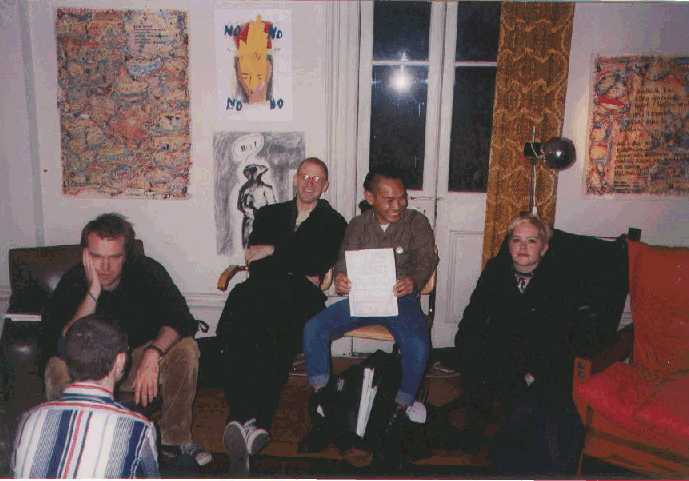
 |
| Above: the artist at Melbourne "Seni Sono" exhibition of underground Indonesian art. |
The Pro-Democratic themes in art were prohibited by Suharto’s New Order
Government. Such a focus was considered provocative in that it can agitate
the masses and upset ‘National Stability’. Consequently pro-democracy activists
and artists are subjected to censorship, arrests and intimidation - all
in the name of National Stability. But oppression eventually dominates
artistic creativity, until finally there is no more freedom of expression.
In the eyes of the Authority, freedom is rebellion, a force set in opposition
to the government's engineered mainstream principles. Our freedom of expression
is shackled, but within those chains lies a source of inspiration; ANGER
IS A GIFT
Many Pro-Democracy artists live in Yogyakarta, and have at one time or
another, attended the Visual Arts Faculty of ISI (Indonesian Arts Institute).
We all 'came of age' a long time after the LEKRA - MANIFES KEBUDAYAAN polemic.
Our generasi (generation, cohort) emerged after the Seni Sono Action in
Yogyakarta (1991), an action that gave birth to a totally new Cultural
Movement in Yogyakarta: GENERASI SENI SONO.
Aksi Seni Sono (the Seni Sono Action) from the beginning was intended as
a protest against an undemocratic decision by the Authority to raze the
Seni Sono Cultural Center without any consultation or deliberation with
the people. The art students considered the Seni Sono Art Center a symbol
of the equal placement of art in the face of politics, business, and power.
Seni Sono was built by the Dutch as an Art Center on the same street corner
where Beringharjo Market, the Post Office, the Bank, Vredeburgh Fortress,
and other centers of Dutch power are located. This central location also
faces the kraton (sultan’s palace) and shares its back boundary with the
presidential palace. Seni Sono lies within the ‘line of power’, the line
that links Mount Merapi to Tugu, to the kraton, down to the beach at Parangkusuma.
All of these places are sacred in Javanese belief. Thus, the authoritarian
decision to destroy this cherished, public landmark in order to expand
the private and very off-limits grounds of the presidential palace, alias
the Authority's elitism, was met by shocked disbelief within the student
community. This sacred, public place was about to be seized without concern
or consideration. The Aksi was held by DSMI (Young Indonesian Artists Council)
with the full support of the broader public. The occupation of Seni Sono
held on for two full months, day and night, and concluded in what we considered
one of the only successful protests in New Order history. Seni Sono was
not destroyed; it was actually renovated.
The most positive outcome of this aksi was the way it led to a new sense
of awareness within the art community (and the broader community) with
regard to our RIGHTS. Finally, with one small success to our credit, the
art community became aware that up till this time our RIGHTS as artists
and as members of Indonesian society have been plundered by the Authority.
The new Generation that emerged with the post-Seni Sono enthusiasm and
taste for public expression has had to work within an atmosphere of renewed
political persecution. The creative process we shared was met with increasing
suspicion and our activities were regularly monitored. Our concern for
the rights of the Indonesian people was considered provocative. As a consequence,
our art works were banned. Even more problematic, we, as artists too could
be branded a SUBVERSIVE with no warning and with no provocation beyond
the simple, but realistic themes seen in our paintings. Many of our paintings
had been black-listed in Indonesia by the absolute power of the Authority.
None could be shown in any official exhibitions. Moreover, several of the
paintings have been confiscated. What’s more, the art community itself
would sometimes back away from supporting fellow artists and even discredit
a work as not artistic because of their own fear of political themes.
The majority of these art works express social criticism toward a system
that favors only the Authority. They also advocate for those that are consistently
defeated by the System. It is our hope that through our art, we can give
rise to a new phenomena: awareness.
In art we trust.